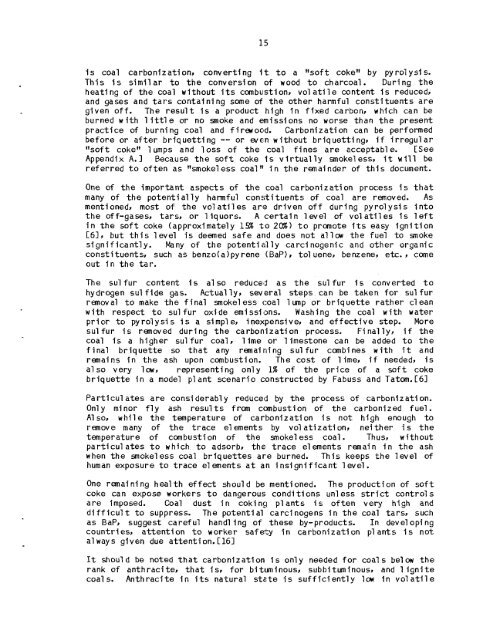Prospects for Coal Briquettes as a Substitute Fuel for Wood and ...
Prospects for Coal Briquettes as a Substitute Fuel for Wood and ...
Prospects for Coal Briquettes as a Substitute Fuel for Wood and ...
You also want an ePaper? Increase the reach of your titles
YUMPU automatically turns print PDFs into web optimized ePapers that Google loves.
15<br />
is coal carbonization, converting it to a "'soft coke" by pyrolysls.<br />
This is simllar to the conversion of wood to charcoal. During the<br />
heating of the coal without its combustion, vol atile content is reduced,<br />
<strong>and</strong> g<strong>as</strong>es <strong>and</strong> tars containing some of the other harmful constituents are<br />
glven off. The result is a product high in fixed carbon, which can be<br />
burned with 1 ittle or no smoke <strong>and</strong> missions no worse than the present<br />
practice of burning coal <strong>and</strong> firewood. Carbonization can be per<strong>for</strong>med<br />
be<strong>for</strong>e or after briquetting -- or wen without briquetting, if irregular<br />
"soft coke" lumps <strong>and</strong> loss of the coal fines are acceptable. [See<br />
Appendix A,] Because the soft coke is vlrtually smokeless9 it w i l l be<br />
referred to often <strong>as</strong> ?"smokeless coal" in the remainder of this document.<br />
One of the important <strong>as</strong>pects of the coal carbonization process is that<br />
many of the potentially harmful constituents of coal are removed. As<br />
mentioned, most of the volatiles are driven off during pyrolysis fnto<br />
the off-g<strong>as</strong>es, tars, or liquors. A certain level of volatiles is left<br />
in the soft coke (approximately 1% to 20%) to promote its e<strong>as</strong>y ignition<br />
C61, but this level is deemed safe <strong>and</strong> does not allow the fuel to smoke<br />
significantly. Many of the potentially carcinogenic <strong>and</strong> other organic<br />
constituents, such <strong>as</strong> benzo(a1pyrene (BaP), to1 uener benzene, etc. , cane<br />
out in the tar.<br />
The sulfur content is also reduced <strong>as</strong> the sulfur is converted to<br />
hydrogen sulfide g<strong>as</strong>. Actually, several steps can be taken <strong>for</strong> sulfur<br />
removal to make the final smokeless coal lump or briquette rather clean<br />
with respect to sulfur oxide emissions. W<strong>as</strong>hing the coal with water<br />
prior to pyrolysis is a simple, inexpensive, <strong>and</strong> effective step. More<br />
sulfur is removed during the carbonization process. Finally, if the<br />
coal is a higher sulfur coal, lime or limestone can be added to the<br />
final briquette so that any remaining sulfur combines with it <strong>and</strong><br />
remains in the <strong>as</strong>h upon combustion. The cost of 1 ime, if needed, Is<br />
also very lowp representing only 1% of the price of a soft coke<br />
briquette in a model plant scenario constructed by Fabuss <strong>and</strong> Tatm.C63<br />
Particulates are considerably reduced by the process of carbonization.<br />
Only minor fly <strong>as</strong>h results from combustion of the carbonized fuel.<br />
Also, while the temperature of carbonization is not high enough to<br />
remove many of the trace elements by volati~ation~ neither is the<br />
temperature of combustion of the smoke1 ess coal. Thus, without<br />
particulates to which to adsorb, the trace elements remain in the <strong>as</strong>h<br />
when the smokeless coal briquettes are burned. This keeps the level of<br />
human exposure to trace elements at an insignificant level.<br />
One remaining health effect shoul d be mentioned. The production of soft<br />
coke can expose workers to dangerous conditions unless strict control s<br />
are imposed. <strong>Coal</strong> dust in coking plants is often very high <strong>and</strong><br />
difficult to suppress. The potential carcinogens in the coal tarsr such<br />
<strong>as</strong> BaP, suggest careful h<strong>and</strong>1 ing of these by-products. In developing<br />
countries, attention to worker safeTy in carbonization plants Is not<br />
a1 ways given due attention. [I61<br />
It should be noted that Carbonization is only needed <strong>for</strong> coals below the<br />
rank of anthracite, that is, <strong>for</strong> bituminous, subbituminous, <strong>and</strong> 1 ignite<br />
coals. Anthracite in its natural state is sufficiently low in volatile

















